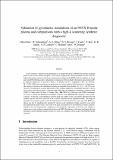Validation of gyrokinetic simulations of a National Spherical Torus eXperiment H-mode plasma and comparisons with a high-k scattering synthetic diagnostic
Author(s)
Ruiz Ruiz, Juan; Guttenfelder, W; White, Andrew E.; Howard, Nathaniel Thomas; Candy, J; Ren, Y; Smith, D R; Gomes Loureiro, Nuno F; Holland, C; Domier, C W; ... Show more Show less
DownloadAccepted version (1.805Mb)
Open Access Policy
Open Access Policy
Creative Commons Attribution-Noncommercial-Share Alike
Terms of use
Metadata
Show full item recordAbstract
A new extensive validation study performed for a modest-beta National Spherical Torus eXperiment (NSTX) neutral beam injection-heated H-mode discharge predicts that electron thermal transport can be entirely explained by short-wavelength electron-scale turbulence fluctuations driven by the electron temperature gradient mode (ETG), both in conditions of strong and weak ETG turbulence drive. Quantitative comparisons between high-k fluctuation measurements (Smith et al 2008 Rev. Sci. Instrum. 79 123501) and simulations are performed via a novel synthetic high-k diagnostic. Computationally intensive electron-scale simulations featuring an unusually large domain (L r, L θ) ∼ (20, 20)ρ s are shown to be required for accurate deployment of the synthetic diagnostic. Ion thermal transport is shown to be close to neoclassical levels, consistent with stable ion-scale turbulence simulations conducted with the GYRO code (Candy and Waltz 2003 J. Comput. Phys. 186 545). Electron-scale GYRO simulations are shown to match the thermal power-balance estimates from TRANSP. The frequency spectra characteristics of electron-scale turbulence (spectral peak and width) can be consistently reproduced by the synthetic spectra, but these reveal not to be a critical constraint on the simulation model. The shape of the high-k wavenumber spectrum and the fluctuation level ratio between the strong and weak ETG conditions can also be simultaneously matched by electron-scale simulations within sensitivity scans about the experimental profile values, and result to be great discriminators of the turbulence models analyzed. Together, electron thermal power comparisons and quantitative agreement of electron-scale turbulence spectra give strong evidence supporting electron-scale ETG fluctuations as the main mechanism driving anomalous electron thermal transport in the two outer-core conditions of the modest-beta NSTX H-mode analyzed.
Date issued
2019-10Department
Massachusetts Institute of Technology. Plasma Science and Fusion Center; Massachusetts Institute of Technology. Department of Nuclear Science and EngineeringJournal
Plasma Physics and Controlled Fusion
Publisher
IOP Publishing
Citation
Ruiz Ruiz, J. et al. "Validation of gyrokinetic simulations of a National Spherical Torus eXperiment H-mode plasma and comparisons with a high-k scattering synthetic diagnostic." Plasma Physics and Controlled Fusion 61, 11 (October 2019): 115015 © 2019 IOP Publishing Ltd
Version: Author's final manuscript
ISSN
0741-3335
1361-6587